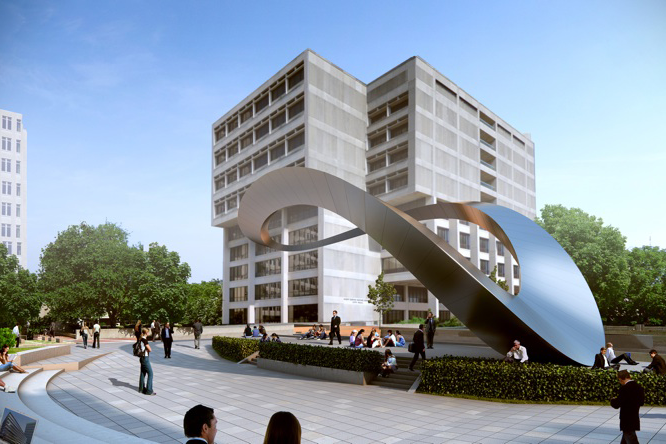PHASE I
Stefanos Polyzoides came to Baton Rouge in April 1997 as the inaugural speaker for the Marcia Kaplan Kantrow Lecture Series for the Baton Rouge Area Foundation. Polyzoides and his partner, Elizabeth Moule were among the founders of the Congress for the New Urbanism. Polyzoides’ lectures on New Urbanism inspired the Baton Rouge Area Foundation to form an initiative to infuse Smart Growth principles into the revitalization of downtown Baton Rouge, making it a livable, sustainable, productive regional center.
APPROACH
In June of 1998, the problems and possibilities of Baton Rouge’s urban landscape became household news. During the week-long charrette led by consultants Duany Plater-Zyberk & Company, Plan Baton Rouge was created from the thoughts and ideas of architects, town planners, developers, property owners, elected officials, civic organizations, community groups, downtown workers, and residents. What emerged was a master plan for the Capitol City’s downtown.
PLANNING
The plan identifies areas where public action can leverage sustained private investment over time. Since 1998, the state and other public agencies have poured $500 million into downtown and the private sector has responded with over $1.5 billion with an additional $900 million in new investment currently planned or under construction. Plan Baton Rouge has been recognized nationally for its success in focusing citizens and public agencies on a common goal.
The plan has guided the growth that has been catalyzed by the State of Louisiana’s ambitious building program occurring in downtown. The Plan also seeks to preserve and strengthen the two historic neighborhoods of Spanish Town and Beauregard Town, and it sets forth a strategy to restore the pedestrian character and sense of place of downtown for all of its citizens to enjoy. The plan was fashioned by a world-renowned consultant team who focused on the physical design of downtown, the connections between the amenities, the transportation challenges, and the retail dynamics. Thus the plan’s flexibility will serve us far into the future as we’ve already witnessed with the evolution of the Shaw Center for the Arts project and the opportunity seized by the private sector. It is a new way of approaching urban planning and development, where public investment leads to long-term, sustained private sector investment.
PHASE II
Following ten years of successful implementation of the original plan, CPEX, in partnership with the Downtown Development District and the City of Baton Rouge, embarked upon the ambitious Plan Baton Rouge Phase II update process in 2008. A decade of progress brought forth by Plan Baton Rouge has left the downtown area a much more vibrant, successful place, but it still awaits the initiatives and improvements that would make it a truly remarkable city center and a source of pride throughout the greater metropolitan area. In response to the region’s need for a truly thriving, purposeful focal point, Plan Baton Rouge Phase II sets out to build on past progress and strategically instill downtown with the qualities worthy of a desirable, flourishing district.
Plan Baton Rouge Phase II will achieve this goal by aggressively promoting initiatives designed to take the downtown area to new levels of activity, livability, and entertainment. While the original plan did well to attract several new restaurants, the Shaw Center, and the Hilton Baton Rouge Capitol Center, too little downtown housing or retail space has followed. It has become clear, even preceding the current economic downturn, that the City must offer new financial incentives and regulatory mechanisms to fulfill the goal of creating more residential, commercial, and entertainment uses for the downtown.
While attracting these additional downtown users will be significant, Phase II goes further to ensure the area progresses nearer to its potential. Priorities of the updated plan include promoting a central green and planting an urban forest, making Third Street a vibrant entertainment corridor, ensuring downtown stays clean and safe, taking advantage of the Mississippi Riverfront, and establishing integrated public parking policies.
By providing strong leadership, seeking expert assistance, and making every effort to involve the community in the planning and implementation process, CPEX seeks to ensure the vision created by Plan Baton Rouge Phase II comes to fruition.
OUTCOMES
- More than 80% of 104 proposals have been implemented
- $500 million of public, $1.5 billion of private funding, and additional $900 million in new investment currently planned or under construction invested downtown since 1998
- State of Louisiana consolidated its campus downtown
- Shaw Center for the Arts created through a complex partnership that includes the Baton Rouge Area Foundation, Louisiana State University and other private entities
- Historic Heidelberg Hotel was renovated and reopened as the Hilton Baton Rouge Capitol Center
- Realignment of River Road slowed down traffic using a 50 mph curve creating a slower, more pedestrian-friendly roadway
- Main Street Market was created through a public-private partnership, providing a small business incubator for entrepreneurs
- CATS downtown trolley transports visitors and state workers throughout downtown and the Capitol Park
- City/State Parking Garage at Third and Convention Streets
- Filled Retail Voids
- Called for additional residential units downtown
- Abandoned and under-used buildings have been renovated and put back into commerce
- II City Plaza Office Tower
- 19th JDC Courthouse
- Bike Path connects Downtown to LSU
- Downtown Development District’s wayfinding signage as part of the comprehensive multimillion dollar visitors’ amenity plan
AWARDS
- Louisiana Chapter of the American Planning Association Outstanding Planning Award for a Plan, Large City, 1999.
- The Louisiana Urban Forestry Council Award for “The Capital City Enhancement Master Plan” promoting urban forestry in Baton Rouge, 2000.




